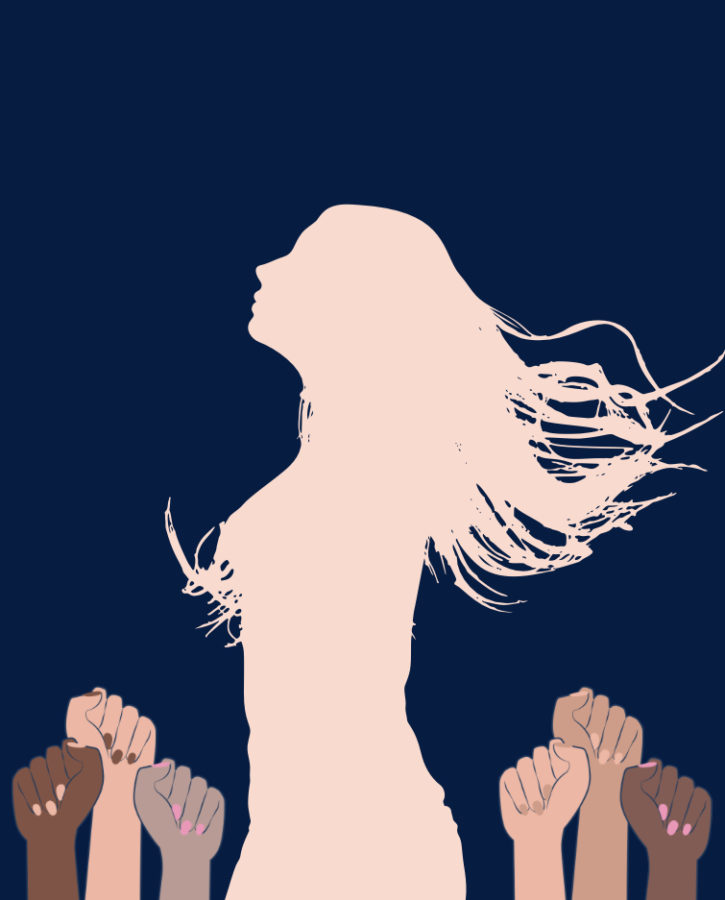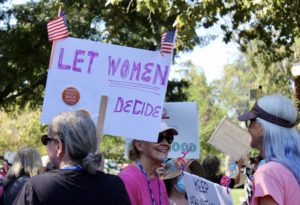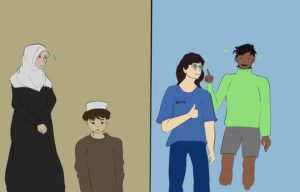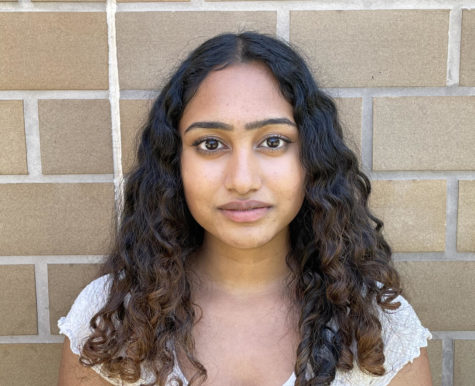International support reinvigorates women’s rights advocacy in Iran
Iranian women struggle to take hold of their natural rights and freedoms.
November 14, 2022
Ongoing protests
On Sept. 16, Mahsa Amini, a 22-year-old Kurdish-Iranian, was traveling to Tehran, the capital of Iran, when she was stopped and arrested by Iranian morality police, who claimed that her hijab was too loose. She fell into a coma and was pronounced dead three days later. Police claimed a heart attack was the cause of her death, however, eyewitnesses at the arrest said Mahsa was beaten by the police. This was later confirmed with photos of her in the hospital covered with bruises and blood.
Her death sparked fury across the streets of Iran, leading to a series of violent protests. According to The New York Times, at least 35 protesters were killed by police brutality on Sept. 23 during the largest anti-government protest since 2009. Videos across multiple social media platforms have shown many women lighting their hijabs on fire and cutting their hair in public, chanting “Women, life, freedom”, to defy the strict women’s clothing laws. Women across the nation tore off their hijabs in solidarity, opposing the government’s corruption and wrongful power over women and their rights. Since the first protests, more women as well as some men, have been coming to the streets of Iran to demand more freedom and to overthrow the nation’s Supreme Leader, Ayatollah Ali Khamenei. In reaction to these protests, authorities have set out to control the protesters, attempting to suppress them with force and violence.
The protests have not only had an influence on Iran but expanded into something everyone around the world is speaking out about The countless videos of protestors on the street and the many news outlets feeding updates on the protesters have sparked important discussions in other nations about how to assist the women in Iran with their fight for women’s rights. As people from all over the world are collaborating to bring more awareness to an issue Iran is trying to hide, protests have fired up in different areas of the world.
Social media has played a big role in connecting individuals around the world to fight for Iranian women. Like the women in Iran who have exposed and cut their hair in protest, many French actresses are joining in solidarity.
A video montage has been widely circulating in France, of many french actresses cutting their hair while also feeding information about Amini’s case with a protest anthem “Bella Ciao” playing in the background. Actress Binoche, who starred in “The English Patient” and “Chocolat”, and Cotillard who starred in “La Vie en Rose”, proudly cut off their hair and shared their sentiments on Instagram. Many other instances of individuals cutting their hair around the world have also sparked debate, such as Turkish pop star Melek Moss who cut her hair in the middle of performing and even Swedish lawmaker Abir Al Sahlani who cut her hair while delivering a speech at an E.U. debate on the protests in Iran at the European Parliament in France.
The act of cutting hair had become a unifying element in the Iran protests and a symbolic feature around the world, so much so that the MAXXI museum in Rome dedicated a campaign to women who want to cut their hair. They developed a station where one would be able to trim their hair in the museum and collect it in a box which the museum hopes to deliver to the Islamic Republic of Iran as a symbolic protest.
The protests have not just impacted Europeans but also Americans who are adamant to bring awareness to the issues in Iran. Many Iranian Americans across the United States have been staging protests to express their reality of the situation.
In Washington, protestors gathered in Farragut Square to express their concern for the situation in Iran while chanting Amini’s name. A candlelight vigil was also held on Oct. 2 in front of the White House where hundreds of individuals came together to mourn the deaths in Iran and show their support for the cause.
Los Angeles is also home to many Iranian immigrants with more than a third of the Iranian immigrants in the US living there. A march was held where protestors walked all the way to the city hall through downtown LA. It was a big event with the beating of drums by marchers and individuals chanting “Free Iran ” while holding signs with messages such as “No to the Islamic Republic” and “Freedom for Iran.”
A demonstration was also held in San Francisco across the Golden Gate Bridge in support of the Iranian protests. Marchers shouted Amini’s name and held up enlarged photos of her. They made the protest personal to each other as they held up images of their loved ones who have died, been tortured, arrested, or missing in Iran.
A decades-long fight
Over the past one hundred years, the rights of women in Iran have been volatile, shifting dramatically based on the authority in power. Women-led feminist advocacy, however, has been persistent.
In the 1920s, the path to gender equality was paved by women’s rights activists in Iran. Women advocated in all sectors, but accessibility to education for young girls was an initial focal point. The number of schools for women increased and Iran’s first university allowed their enrollment.
The establishment of formal organizations and the Iranian Women’s Party in 1942 allowed for significant strides in their movement for suffrage. Women gained the right to vote in 1963. This unified movement that enjoyed the support of the government was also able to expand marriage and child custody rights under the Family Protection Law, as well as increase the minimum age to marry from 13 to 18.
In the 1970s, Iran’s parliament consisted of several women. More took up positions in local government.
The Pahlavi dynasty, the last dynasty of Iran, ruled for 54 years. The Shah, Mohammad Reza Pahlavi, was receptive to progress, resulting in a period of modernization from 1925 to 1979. The Shah’s twin sister, Ashraf Pahlavi, was a strong proponent of women’s rights, working in the High Council of Women’s Organizations of Iran.
In 1979, the Pahlavi dynasty lost power through the Islamic Revolution, shifting the country’s political structure to a theocratic republic that has, since 1979, unraveled the progress made in furthering women’s rights. Many rights in family law were rolled back, the minimum age of marriage was lowered to nine and many women had to leave roles in the government.
Continued activism has allowed women to maintain some rights, access to education and voting rights being some of the most critical. Advocates have been able to win a few victories, like increasing the minimum age of marriage back to 13, but women are still subject to severe discrimination under the law.
The resiliency of the women of Iran is embedded in their history. Modern-day protests find their roots in the feminist resistance that was prevalent throughout the 20th century.
Hope for future progress
The protests in Iran have not just connected people around the world but also united them in fighting for a broad, singular cause, women’s rights. Women in Afghanistan have related to their Iranian neighbors in their fight for women’s rights and protested for Iran while also fighting against the Taliban. A demonstration took place where 30 women in headscarves chanted “Women, Life, Freedom” in front of the Iranian Embassy in Kabul. Soon after, Taliban Security Forces broke up the protest with brute force, fired in the air, and tore up the banners.
A protester who wanted to remain anonymous for their safety stated in the Voice of America that, “We are sure that one day, our people will rise the same way as the Iranian people”
The protests have also expanded to a greater political sphere where nations imposed sanctions on the wrongdoing of the Iran police and to show their support for the Iranian women protesting for their rights.
The United Kingdom had imposed sanctions against the Iranian police through strict policy. The Foreign Office sanctioned the entire Iranian police force and banned ny from coming to the UK. They had also frozen their assets if they had any in the UK. They also specifically sanctioned two of the commanders including the chief, Mohammed Rostami Cheshmeh Gachi and the division head of Tehran, Haj Ahmed Mirzaei. Other figures include five political and social officials, one of them Gholamreza Soleimani who is the head of the Islamic Revolutionary Guard Corps Basij force. Canada also followed a similar sanction on the Iranian police.
The United States had also responded to the current situation in Iran by imposing sanctions through the US Department of the Treasury’s Office of Foreign Assets Control (OFAC) for abuse and violence against Iranian women. The OFAC is targeting specific individuals such as the senior leaders of Iran’s security organizations which are the Morality Police, Ministry of Intelligence and Security, Army’s Ground Forces, Basij Resistance Forces and Law Enforcement in Iran. The individuals listed will have their property and interest in the US blocked and reported to the OFAC.
U.S President Joe Biden spoke about the situation in Iran in his speech to the United Nations General Assembly, and showed his support for the women in Iran. He gave some comments about his opinion on the situation and spread some words of affirmation to their struggle. Biden has continued to make comments and share his opinion on the issues.
“Women all over the world are being persecuted in various ways, but they should be able to wear in God’s name what they wanna wear. No one should be telling them what to wear.” Biden stated.
The issue the Iranian women are fighting falls under the broader fight for women’s rights, which many women around the world have been fighting for for decades. From the Supreme Court ruling of Roe v. Wade, bans on hijabs in India, and the Morality Police in Iran all fall under the one problem of women’s rights. These protests proved that it was an issue that everyone around the world should care about, and many nonprofit organizations have been built to help aid the women protesting on the streets of Iran. The Iranian American Women Foundation is accepting donations to help empower the young generation of Iranian women around the United States and the world. United for Iran is another organization that is helping civil liberties in Iran and accepts donations for their work, they are located in San Francisco. The Women’s Committee Of the National Council of Resistance Of Iran is also aiding by adding funds to continue their work in getting rid of gender based inequalities in Iran. The fight in Iran is not just confined to Iran but included the entire world under the wing of women’s rights.






